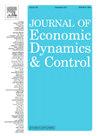使用业务趋势调查的基于微数据的产出缺口估计
IF 2.3
3区 经济学
Q2 ECONOMICS
引用次数: 0
摘要
本研究采用微观计量经济学模型,通过分析企业趋势调查和年度企业活动报告的微观数据来估计产出缺口。我们应用控制函数方法来估计包含有关企业产能利用水平信息的特定部门生产函数。为了构建潜在产出的综合指数,我们从企业层面的数据中提取统计趋势来计算潜在投入值,然后将其输入到生产函数中。然后,我们计算基于微数据的地区、部门和整体经济的产出缺口。随后,我们将总产出缺口分解为三个主要部分:基于资本、劳动力和产能利用的产出缺口,以及加权部门和地区产出缺口。我们通过分析波兰的制造业、建筑业和服务业来验证我们的方法,突出其优势和局限性。我们的研究结果表明,产能利用率有效地捕捉了未经调整的全要素生产率指数中的商业周期成分。最后,我们证明了基于微数据的产出缺口度量是菲利普斯曲线中重要的解释变量。本文章由计算机程序翻译,如有差异,请以英文原文为准。
Microdata-based output gap estimation using business tendency surveys
This study employs a micro-econometric model to estimate output gaps by analysing microdata from business tendency surveys and annual enterprise activity reports. We apply the control function method to estimate sector-specific production functions that incorporate information about firms' capacity utilisation levels. To construct aggregate indices of potential output, we calculate potential input values by extracting statistical trends from firm-level data and then input them into production functions. We then compute microdata-based output gaps for regions, sectors, and the total economy. Subsequently, we decompose the total output gap into three primary components: capital-, labour-, and capacity utilisation-based output gaps, as well as weighted sectoral and regional output gaps. We validate our methodology by analysing the Polish manufacturing, construction, and service sectors, highlighting its strengths and limitations. Our findings reveal that capacity utilisation effectively captures the business cycle component within unadjusted total factor productivity indices. Finally, we demonstrate that microdata-based output gap measures are significant explanatory variables in the Phillips curve.
求助全文
通过发布文献求助,成功后即可免费获取论文全文。
去求助
来源期刊

Journal of Economic Dynamics & Control
ECONOMICS-
CiteScore
3.10
自引率
10.50%
发文量
199
期刊介绍:
The journal provides an outlet for publication of research concerning all theoretical and empirical aspects of economic dynamics and control as well as the development and use of computational methods in economics and finance. Contributions regarding computational methods may include, but are not restricted to, artificial intelligence, databases, decision support systems, genetic algorithms, modelling languages, neural networks, numerical algorithms for optimization, control and equilibria, parallel computing and qualitative reasoning.
 求助内容:
求助内容: 应助结果提醒方式:
应助结果提醒方式:


